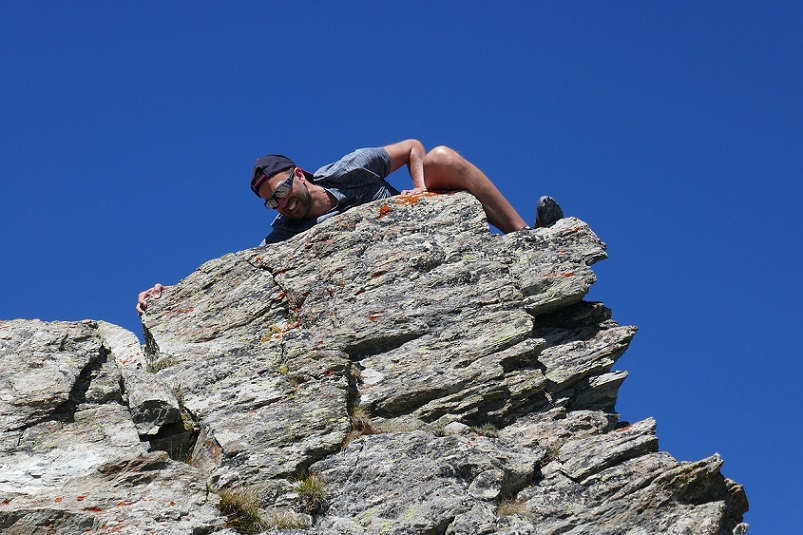Perfecting their technique should be the goal of every serious rock climber. With a firm handle on technique, climbers can improve their skill level and safely tackle more difficult climbs.
Today, I want to discuss another fundamental rock climbing technique: mantling.
Every climber should be familiar with this powerful technique. With the mantle under your belt, you’ll be better able to navigate and finish climbs.
If you’re ready to take the next step in your journey to becoming a better climber, check out the guide below. In it, I’ll explain what you need to know about mantling so that you can get started practicing it today!

What is Mantling?
Let’s start with the easy question:
What is mantling?
At its core, mantling allows climbers to surmount ledges and cliff-faces. Chances are you’ve encountered this technique before in your life even if you’ve never been rock climbing.
Have you ever pulled yourself out of a swimming pool? Did you climb any kitchen counters or other ledges as a child?
If so, you’ve completed a very rudimentary version of the mantle.
Applying these skills to your rock climbing endeavors can greatly increase the quality of your climbs.

Is Mantling Hard?
Despite this, many consider mantling to be an intermediate-level skill. Because mantling involves climbing without the use of handholds, it can often be a more difficult skill to grasp.
In essence, mantling requires that you’ll push yourself up without anything to pull up on. By its nature, mantling requires one to push up, instead of pulling.
Because of this, mantling differs from other common rock climbing techniques and can take time to master.
However, don’t let this stop you. With adequate practice, you can get the hang of mantling in no time.
Why Is Mantling Important?
Rock climbing was born from man’s desire to reach the top of even the highest of mountains.
And though much has changed since then, the conquest of the climb remains a moral victory for many climbers.
So what am I trying to get at?
It’s simple:
You’re never going to crest the top of certain rockfaces if you haven’t learn how to mantle. In a way, you can consider this intermediate-level technique a right of passage of sorts.
With successful mastery, you’ll do more than crest ledges and other rockfaces. You’ll join the ranks of all the other rock climbers who have managed to pull off similar endeavors.
And as your skills and confidence continue to grow, you’ll be able to move towards even more complicated techniques.
As great as this sounds, let’s focus on one step at a time. First, you’ll need to learn how to mantle, so let’s take a look at this technique more in depth.
How Do You Mantle?
As noted, mantling differs from other common rock climbing techniques in that it requires pushing, and not pulling, motions.
Because of this, mantling targets different muscle groups—namely your triceps. Make sure that you have sufficient triceps development to lift yourself up and over ledges of varying heights. If not, you won’t be able to complete this technique.
With that in mind, let’s take a look at some of the particulars behind mantling.
Let’s say that you’ve reached the top of the cliff, and you’re ready to pull yourself over to the top.
In order to do so, you’ll need to use the mantling technique. Check out this step-by-step guide to make sure that you use this technique correctly every time!
1. Chalk Your Hands
Before you attempt to mantle, make sure that your hands are sufficiently chalked. You want to have as much grip as possible.
2. Plant Your Palms
Next, you’re going to place your palms on the ledge you’re looking to climb. Make sure that they are face down so that you can push up from them later.
3. Place Your Feet as High as Possible
Next, if you can, bring one foot up. The higher your foot, the more control you will have later when you attempt to execute the move.
Higher feet help re-center your mass, giving you the flexibility you need to lunge over the ledge later with your hips.
Even if you can’t place your foot completely over the ledge, place it high enough to get a good smear. You may want to bend the knee of the raised leg for better positioning.
4. Push Up and Extend Your Arms
Next, push up from your palms, locking your arms as you do so. Additionally, you’ll want to extend from your raised leg.
5. Use Your Hips to Cross the Ledge
Depending on how high the ledge is, you may have to use your hips to twist your other leg across the ledge.
When Should You Use the Mantling Technique?
Keep in mind that mantling isn’t always about reaching the top. There may be times when you need to use mantling simply because your next hand hold is too high—or you may need to reach a brief summit during a multi-pitch route.
Some mantles will be easier to do than others. For some, you may simply need to lift your arms and twist your body over.
No matter the case, be sure that you confidently execute the technique. It can be easy to feel vulnerable when mantling—especially if you’re doing it from a distance high in the air.
For this reason, make sure that you’re calm when attempting to mantle. With the proper strength and training, mantling doesn’t have to be hard. However, it will always require a lot of focus. By staying zoned in and not getting distracted, you can mantle in no time.
Ultimately, with enough practice you can overcome any worries you may have about mantling. And, as you gain more experience, you’ll get a better feel for the best mantling technique for the situation.
Keep the above information in mind as you look to start practicing mantling. With a detail-oriented training approach, you can expect better results faster.






